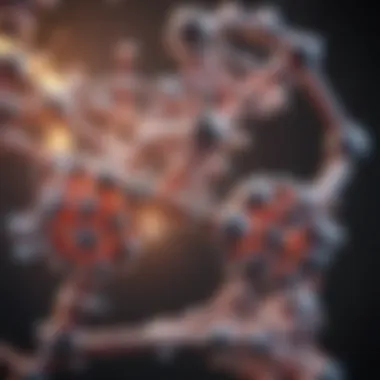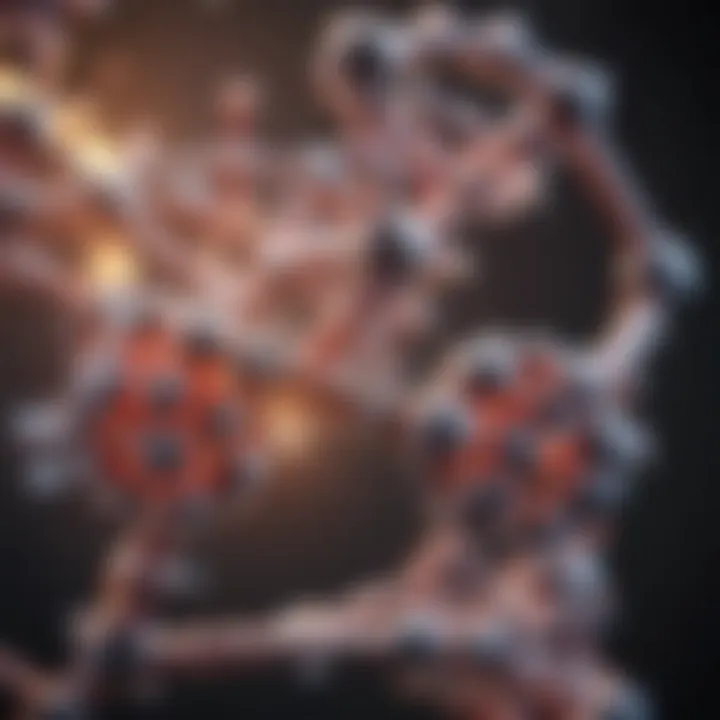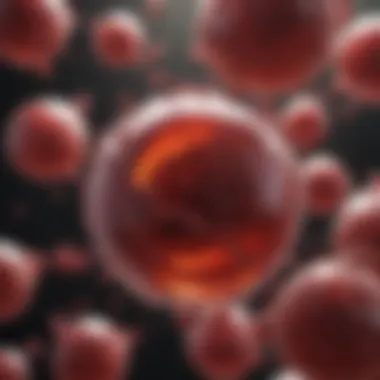Exploring the EPO Gene: Insights into Erythropoiesis


Intro
The realm of genetics is a labyrinthine network of intricacies, where each gene plays a pivotal role in shaping the organism's biology. One such gene that has attracted considerable attention in recent years is the EPO gene, notably tethered to the process of erythropoiesis, or red blood cell formation. The EPO gene’s significance extends beyond mere biological function; it features prominently in discussions ranging from sports ethics to therapeutic advancements in various medical conditions.
Understanding the EPO gene is akin to peeling an onion—every layer uncovers new facets and complexities. With its bioactive product, erythropoietin, this gene not only regulates red blood cell production in the bone marrow but also serves as a key player in our body’s responses to low oxygen levels, often referred to as hypoxia. The gene’s story is interwoven with themes of survival, adaptation, and revolution in biomedical research.
In this article, we will embark on a journey through the vast landscape of the EPO gene, shedding light on its foundational role in both healthy and pathological conditions. We will explore developments in understanding its molecular mechanisms, its therapeutic implications in disorders like anemia, and controversial matters surrounding its use in competitive sports.
As we delve deeper, we aim to engage a knowledgeable audience, offering insights not only for students and researchers but also for professionals navigating the evolving world of genetic science. By the end, readers should not only grasp the scientific underpinnings of the EPO gene but also appreciate its implications for society and medicine.
Prelude to the EPO Gene
The exploration of the EPO gene is pivotal as it plays a significant role in our understanding of oxygen transport in the body. EPO, short for erythropoietin, is a hormone produced primarily in the kidneys and is crucial for regulating the production of red blood cells. This gene not only aids in hematopoiesis—the process of blood formation—but also contributes to our broader biological responses to hypoxia, or low oxygen availability. In considering the implications and insights surrounding the EPO gene, one must ponder its involvement in numerous physiological and pathological states, ranging from chronic diseases to potential therapeutic uses.
Definition and Background
The EPO gene is responsible for encoding the erythropoietin hormone. This small peptide hormone is vital in stimulating the bone marrow to increase red blood cell production, particularly in response to decreased oxygen levels in the bloodstream. The regulation of the EPO gene is complex, influenced by several factors including oxygen levels, cytokines, and various signaling pathways. In essence, when oxygen is scarce, the gene is activated to produce more EPO, prompting the production of additional red blood cells that can carry more oxygen to vital tissues. This natural feedback mechanism ensures that the body can adapt to changes in oxygen availability effectively.
Historical Overview
Delving into the history of the EPO gene reveals a rich narrative of scientific inquiry. Initially characterized in the late 20th century, its discovery was a game changer in the fields of hematology and sports medicine. In the early 1980s, scientists identified the hormone erythropoietin itself, but it wasn’t until 1985 that the gene responsible for its production was cloned. This breakthrough led to the first recombinant EPO products, transforming the treatment landscape for patients suffering from anemia, particularly those with chronic kidney disease or undergoing chemotherapy. The historical evolution of the EPO gene reflects the progression of our understanding of gene therapy and biotechnology.
"The history of the EPO gene illustrates not just scientific progress, but also raises pertinent questions about application and ethics within the medical field."
Thus, understanding the EPO gene encapsulates a journey through genetics, physiology, and medical ethics, making it a fascinating subject for further exploration.
Structure of the EPO Gene
Understanding the structure of the EPO gene is pivotal in grasping its functional complexities and implications. The EPO gene, located on chromosome 7, is crucial for coding the erythropoietin protein. This protein plays a fundamental role in the production of red blood cells, which in turn influences oxygen transport throughout the body. By examining the genomic localization and protein structure, one can appreciate not only how this gene operates but also how variations or mutations can have far-reaching effects in health and disease. The nuances of the EPO gene's structure are instrumental in both theoretical and practical contexts, particularly in fields like genetics, medicine, and therapeutic research.
Genomic Localization
The precise location of the EPO gene on chromosome 7 is significant for several reasons. It resides in a region known as 7q11.2, which is the short arm of the chromosome. This genomic placement can affect gene regulation and expression—factors that are pivotal when considering the synthesis of the erythropoietin protein. It’s fascinating to note that the EPO gene is surrounded by other genes that may also be implicated in erythropoiesis. The concept of gene clustering suggests that these neighboring genes can interact and influence one another’s activity, potentially affecting the overall production of mature erythrocytes.
To bolster our understanding, research shows that hypoxia, or low oxygen availability, activates the EPO gene via a complex network involving hypoxia-inducible factors (HIFs). These transcription factors bind to the regulatory regions of the gene, promoting its expression in response to fluctuating oxygen levels. Additionally, other conditions and hormones, such as androgens and growth factors, can modulate EPO activity, thereby demonstrating the gene's adaptability and significance in our physiology.
Protein Structure
The protein produced by the EPO gene, also called erythropoietin, features a distinctly structured formation that is crucial for its function. Erythropoietin is primarily a glycoprotein with a mature structure composed of approximately 166 amino acids. Its three-dimensional shape is vital; it includes an alpha-helical configuration which not only determines its stability but also its ability to bind to erythropoietin receptors located on red bone marrow cells. This binding initiates a signaling cascade that encourages the production and maturation of red blood cells.
Interestingly, the glycosylation of erythropoietin—where carbohydrate molecules attach to the protein—serves to enhance its stability in circulation and also plays a role in its biological activity. This modification can affect the half-life of the protein in plasma, impacting how long it remains active in the body post-synthesis.
Additionally, mutations or abnormalities in the structure of either the EPO gene or the resultant protein can lead to clinical implications. For example, point mutations could hinder its functionality, resulting in conditions such as anemia, where the body fails to produce adequate red blood cells.
"The structure of the EPO gene not only provides insight into its function but also into how genetic variations can manifest in critical health conditions."
The detailed analysis of both the genomic localization and protein structure of the EPO gene facilitates key insights that resonate within the realms of genetic research, clinical studies, and practical applications in treatment methodologies. Understanding these components can lay the groundwork for potential novel therapies and illuminate the pathways through which the EPO gene plays a role in maintaining bodily health.
Function of the EPO Gene
The function of the EPO gene plays a pivotal role in both physiological and pathological states. Understanding this gene is crucial because it offers insights into how our body regulates red blood cell production and oxygen transport, key elements in maintaining optimal bodily functions. EPO, or erythropoietin, is not just any ordinary hormone; it is essential for erythropoiesis, the process through which red blood cells are formed. This function directly connects to a variety of conditions, from athletic performance to serious health issues like anemia. Knowing how EPO works offers significant benefits, especially regarding therapeutic applications and health interventions.
Role in Erythropoiesis
Erythropoiesis is a finely tuned process, and the EPO gene is at its heart. When oxygen levels in the blood drop, the kidneys detect this change and ramp up the production of erythropoietin. This hormone then travels to the bone marrow, where it stimulates the production of red blood cells.
The key takeaway here is that without EPO, our bodies would struggle to generate enough red blood cells, leading to oxygen deficiencies. This mechanism is especially important in scenarios where oxygen demand escalates, such as during high-altitude exposure or strenuous exercise.


"EPO's rapid response is crucial; it's our body's way of ensuring that every organ gets the oxygen it needs, especially when times get tough."
In more specific circumstances, like significant blood loss or certain chronic conditions, the body's ability to produce EPO might not suffice. Here, administering synthetic EPO can be lifesaving. This intervention has transformed how we treat conditions associated with low red blood cell counts. After all, with the EPO gene in command, our body remains agile and responsive to its requirements.
Influence on Oxygen Transport
The influence of the EPO gene on oxygen transport extends beyond merely increasing blood cell count; it fundamentally alters how effectively our bodies utilize oxygen. Once the red blood cells are formed and released into circulation, hemoglobin within those cells binds to oxygen molecules. EPO ensures that the bone marrow produces these blood cells in adequate amounts, enhancing the capacity of the blood to carry oxygen.
This effect can be particularly pronounced in athletic contexts. Athletes often harness this function, intentionally or not, to enhance performance. A higher count of red blood cells translates into more oxygen transported to muscles during intense activities, thereby improving endurance. However, this raises questions about the integrity of sports. The line between optimal performance and unethical practices like EPO doping can sometimes blur.
In addition to athletics, the implications of EPO’s role in oxygen transport have been recognized in clinical settings, particularly in patients with chronic diseases. For instance, individuals with kidney disease often experience an EPO deficiency, leading to anemia. In these situations, supplementing with EPO-based therapies can lead to remarkable improvements in their overall quality of life, aiding energy levels and reducing fatigue.
In essence, the EPO gene is not merely a genetic element; it is a vital part of our biological fabric that helps us navigate the complexities of life, from peak athletic performance to recovery from disease.
The EPO Gene in Health
The EPO gene plays a crucial role in maintaining overall health, particularly in the regulation of red blood cell production. Understanding this gene’s function gives us insight into how our bodies adapt to varying conditions and underscores its significance in both normal physiological processes and in response to external factors. Let’s dive deeper into this subject by discussing its normal physiological regulation as well as its impact on exercise and altitude.
Normal Physiological Regulation
At the heart of the EPO gene’s function lies its influence on erythropoiesis, the process of producing red blood cells. Under normal conditions, the expression of erythropoietin, the hormone encoded by the EPO gene, is primarily regulated by oxygen levels in the bloodstream. When oxygen levels drop, such as when someone is at a high altitude or experiencing a respiratory issue, the kidneys sense this deficit and respond by producing more EPO. This increase in EPO stimulates the bone marrow to produce more red cells, enhancing the blood’s oxygen-carrying capacity.
"Without EPO, the body’s ability to adapt to lower oxygen levels would be compromised, leading to potential health issues like fatigue and cognitive impairments."
This regulation is not a standalone mechanism but is influenced by other factors, such as iron availability and hormonal balance. When everything works as it should, it outcomes a finely tuned system that ensures sufficient red blood cell levels to meet the body’s demands. Any dysfunction in this regulation can lead to complications, including anemia, where the body isn’t able to produce enough red blood cells.
Impact of Exercise and Altitude
As we turn our attention to the realms of exercise and altitude, the EPO gene displays its remarkable importance. During physical exertion, our muscles require more oxygen, leading to an increase in EPO production. Endurance athletes, for instance, often experience elevated levels of this hormone, which enhances their aerobic capacity and supporting performance. Moreover, training at high altitudes, where oxygen is scarce, can trigger a significant uptick in EPO production. This response primes the body for improved oxygen delivery during intense physical activity.
The adaptation process can yield long-term benefits for athletes, as it allows the body to become more efficient at utilizing oxygen. Research indicates that individuals who regularly engage in high-altitude training may develop a more robust set of physiological adaptations that hone their performance over time.
In short, understanding the impact of EPO in the context of health demonstrates how bodily mechanisms are finely tuned to respond not just to internal changes but also to external challenges. Recognizing these elements provides valuable insights for both researchers interested in genetic contributions to health and athletes seeking optimal performance.
By integrating knowledge of the EPO gene's normal regulation with its response to environmental challenges, we illuminate the broader implications it holds for enhancing health and well-being.
The EPO Gene in Disease
When investigating the relationship between genetics and health, the EPO gene emerges as a crucial element. This gene isn't just a mere contributor to blood formation; its implications stretch into various diseases, altering how we understand and approach their treatment. The intricate interplay between the EPO gene and specific diseases like anemia and cancer calls for a closer examination, revealing both the potential for therapeutic applications and the complex biological mechanisms underpinning these conditions.
Anemia and EPO
Anemia, a condition characterized by a deficiency in the number or quality of red blood cells, is intricately linked to the EPO gene. Essentially, EPO, or erythropoietin, stimulates the production of red blood cells in the bone marrow in response to low oxygen levels in the blood. When the EPO gene functions properly, it ensures that our body maintains adequate oxygen transport. However, in cases of anemia, this process can falter.
In individuals with chronic kidney disease, for instance, the kidneys may not produce sufficient EPO, leading to anemia. This connection has become a focal point for therapeutic interventions. EPO-stimulating agents, often synthesized for clinical use, can help manage anemia by mimicking the natural hormone, encouraging red blood cell production and alleviating fatigue and weakness associated with the condition.
Moreover, the underlying mechanisms of anemia extend beyond the kidney's ability to produce EPO. Nutritional deficiencies, genetic disorders, and inflammatory conditions can all impact red blood cell production. This multifaceted nature of anemia highlights the importance of understanding EPO's role not only as a treatment option but as a biomarker for various underlying health issues.
Role in Cancer Biology
The role of the EPO gene in cancer biology is equally compelling, as it signifies a dual nature. On one hand, certain tumors have been shown to overexpress EPO, contributing to a mechanism known as tumor hypoxia, where the tumor creates a low oxygen environment. In order to adapt to the lack of oxygen, the tumor manipulates surrounding cells and may even stimulate red blood cell production to enhance its own survival at the expense of surrounding healthy tissues. This presents a real challenge for treating cancers effectively, as the EPO signal can inadvertently support tumor growth.
On the other hand, EPO has also been examined for its potential benefits in cancer therapy. For patients undergoing chemotherapy, EPO-stimulating agents can combat treatment-related anemia, thus improving the quality of life and enabling better tolerance to prescribed therapies.
Advances in research have led to targeted therapies aiming to inhibit the EPO receptor in specific cancer types, creating new avenues for treatment strategies.
Understanding the EPO gene's dual role in cancer can provide invaluable insights, driving forward innovative treatment approaches.


In summary, the EPO gene's implications in diseases like anemia and cancer reveal a complex landscape where genetics, pathology, and therapy intersect. By delving into these relationships, we not only foster a deeper comprehension of diseases but also pave the way for novel therapeutic interventions that can enhance patient outcomes.
Clinical Applications of EPO
The EPO gene holds a crucial place not just in our understanding of cellular biology, but also in its wide array of clinical applications. This gene, which encodes erythropoietin, has significant implications in therapeutic medicine, particularly concerning conditions where oxygen transport is compromised or blood production is insufficient. Given the frequency of these health issues, acknowledging and harnessing the potential of EPO is essential.
Therapeutic Uses
The therapeutic applications of EPO are particularly evident in the context of treating anemia, especially in patients suffering from chronic kidney disease or those undergoing chemotherapy. When we’re dealing with reduced erythropoiesis, which translates to lower red blood cell counts, administering synthetic erythropoietin can lead to substantial improvements in hemoglobin levels and overall patient vitality.
Key Therapeutic Uses of EPO Include:
- Chronic Kidney Disease: Patients with end-stage renal disease often experience reduced erythropoietin production. EPO administration can help manage anemia effectively.
- Cancer Treatment: Cancer patients undergoing various treatments frequently face anemia. EPO has been used to mitigate this problem, allowing for better management of treatment side effects.
- Surgical Recovery: Certain surgical patients benefit from EPO treatment since it encourages quicker recovery post-surgery by boosting red blood cell production.
- Preterm Births: In some cases, EPO has been explored for its potential roles in improving outcomes for infants born prematurely, indicating its expansive influence.
While these treatments may seem advantageous, they are coupled with regulatory considerations and patient safety measures, which cannot be overlooked.
EPO in Sports Medicine
In the realm of sports medicine, EPO presents a dual-edged sword. On one hand, its ability to enhance athletic performance through improved oxygen delivery makes it a point of interest. On the other hand, it has cultivated a concerning trend of doping in competitive sports. Its use among athletes, although appealing for its performance-enhancing benefits, has brought about serious ethical discussions and calls for stringent regulations within sporting organizations.
Considerations for EPO Use in Sports Include:
- Performance Enhancement: Athletes using EPO can experience increased stamina and endurance, making it attractive for endurance sports such as cycling, long-distance running, and cross-country skiing.
- Doping Concerns: The International Olympic Committee and other sports authorities have imposed strict regulations against EPO, as its misuse undermines fair competition and poses health risks to athletes.
- Health Risks: Misusing EPO can result in elevated hemoglobin levels, which may lead to a higher risk of thrombosis and cardiovascular complications.
"The potential benefits of EPO must be weighed against the ethical concerns and health risks it poses, especially in the competitive sports arena."
In summary, while the clinical applications of EPO in therapeutic settings showcase its immense potential to alleviate specific health conditions, its implications in sports medicine raise critical concerns that intertwine ethics and public health. As research continues to evolve, maintaining a balance between efficacy and integrity remains paramount.
Ethical Considerations
Understanding the ethical considerations surrounding the EPO gene is crucial in the context of its applications in sports, medicine, and genetic research. The implications of gene manipulation and doping are profound and can influence not just individual athletes but the integrity of sports and the broader society as well.
EPO Doping in Sports
Erythropoietin (EPO) has garnered attention in the world of sports due to its performance-enhancing capabilities. Athletes may misuse EPO to increase red blood cell mass, thus boosting oxygen delivery during endurance events. This practice raises critical ethical questions about fairness in competition.
Many people see doping as a way to level the playing field, especially in sports where advantage is often gained by the slightest margin. However, this is a slippery slope. Doping can lead to health risks, as misuse of EPO is associated with complications such as hypertension and increased risk of thrombosis. Moreover, the essence of sports is about fair competition. If athletes start relying on these substances, it undermines the dedication and hard work that are core to athletic achievement.
Some key points include:
- Health Risks: Athletes might experience short-term gains but risk long-term health.
- Integrity of Sports: Doping erodes trust in sports. Fans expect authenticity.
- Legal Ramifications: Use of performance-enhancing drugs can lead to bans and legal issues.
“In every competition, the spirit of sportsmanship should reign supreme, and the use of performance enhancers disrupt that very essence.”
Regulatory Framework
The regulatory framework that governs the use of EPO in sports aims to uphold fair play and protect athletes. Organizations like the World Anti-Doping Agency (WADA) have established strict guidelines to control the use of EPO and other performance-enhancing substances. These regulations not only spotlight individual athletes but also emphasize the responsibility of sports organizations to enforce compliance.
Key elements of this framework include:
- Testing Protocols: Athletes are subject to routine testing for performance-enhancing drugs including EPO. Random, out-of-competition testing helps deter doping.
- Education Initiatives: Preventive measures such as educational programs on the risks of drug abuse and the importance of honesty in sports can help.
- Sanctions and Penalties: Doping offenses can result in severe repercussions including suspensions and bans, emphasizing serious consequences.
Outside the realm of sports, the ethical landscape surrounding EPO research is equally intricate. Researchers must navigate the ramifications of genetic progress while considering the moral implications of their discoveries in society. Balancing innovation with ethical responsibility remains a continual challenge in the scientific community.
Overall, engaging with ethical considerations surrounding the EPO gene encourages not just a reevaluation of practices in sports but prompts deeper questions about human enhancement and societal values.
Genetic Engineering and EPO


Genetic engineering, particularly in the context of the EPO gene, represents a frontier with both significant promise and considerable ethical dilemmas. The ability to manipulate genes such as EPO using modern technologies allows us to explore new horizons in medicine and biology. This conversation is particularly fascinating for students, researchers, and professionals eager to grasp the intersection of genetics with health sciences.
CRISPR and Gene Editing
CRISPR-Cas9 has quickly become the poster child of genetic engineering, and its application to the EPO gene is no exception. The technology allows scientists to target specific sequences within the DNA, enabling precise edits that can either activate or deactivate the expression of EPO. This specificity is essential for creating modifications that can treat illnesses or enhance physiological functions without generating unintended consequences.
Imagine using CRISPR to enhance EPO production in patients suffering from chronic illnesses like renal failure. It’s not merely about creating higher levels of erythropoietin, but about tailoring treatments that fit an individual’s genetic makeup. Such precision might lead to customized therapies tailored to the needs of each patient, leading to more effective management of conditions such as anemia.
Moreover, as researchers delve deeper into the therapeutic aspects of the EPO gene, gene editing might open doors to entirely new treatment modalities. These include potential applications in gene therapy, where the goal is to provide a lasting effect rather than managing symptoms with continual pharmacotherapy.
"Genetic engineering via CRISPR not only holds the promise of enhanced understanding of the EPO gene but also points toward practical applications in clinical settings."
Potential for Gene Therapy
As we navigate the landscape of EPO and its genetic underpinnings, the potential for gene therapy stands out as a beacon of hope, particularly for individuals with hereditary conditions that affect erythropoiesis. Gene therapy aimed at the EPO gene could, in theory, provide a one-time treatment that restores normal blood function.
This possibility raises critical questions about feasibility and ethics. What happens when we can potentially cure conditions that once required lifelong intervention? There may be profound implications for healthcare systems and patient lives. For patients suffering from genetic forms of anemia, gene therapy targeting EPO could eliminate the need for frequent blood transfusions, drastically improving quality of life.
However, concurrent with this promise are concerns about the long-term effects of such interventions. Will we witness unexpected outcomes as a result of gene editing? Can we ensure the safe integration of modified genes into human DNA? These questions must be answered thoughtfully by the scientific community, necessitating transparent research and discussion about the implications of tampering with our genetic blueprint.
In summary, while the potentials of CRISPR and gene therapy applications regarding the EPO gene are captivating, a cautious approach combined with robust research is warranted. Researchers must strike a balance between innovation and ethical practice, keeping the welfare of patients at the forefront of their work.
Future Directions in EPO Research
The EPO gene has been at the forefront of genetic research, and its implications extend far beyond simple blood health. As scientists peel back layers on its functionality, the future landscape of EPO research presents numerous avenues worth traversing. This section delves into emerging technologies and collaborative research approaches that promise to unveil new dimensions in our understanding and application of this essential gene.
Emerging Technologies
Recent advancements in biotechnology are poised to revolutionize the study of the EPO gene. Among the most notable of these is the application of CRISPR technology, which allows for precise editing of genetic sequences. Using CRISPR-Cas9, researchers can modify the EPO gene in model organisms. This direct manipulation paves the way for the exploration of its effects on erythropoiesis at an unprecedented detail.
The use of single-cell RNA sequencing technology is another feather in the cap of modern genetic research. This method permits scientists to analyze the expression of the EPO gene in individual cells, providing insights into how cellular environments influence its activity. This is crucial, as variations in EPO expression could significantly impact blood oxygen levels, particularly in varying physiological conditions like high altitudes or during intense exercise.
Furthermore, advances in bioinformatics, utilizing machine learning algorithms, can predict the behavior of the EPO gene within complex networks of gene regulation. By analyzing vast amounts of genetic data, researchers can uncover hidden interactions between EPO and other genes, which can lead to groundbreaking discoveries in disease treatments and gene therapies.##
Collaborative Research Approaches
Unlocking the full potential of EPO research requires a cooperative effort across multiple domains and disciplines. Interdisciplinary collaboration is paramount; combining insights from genetics, physiology, and medicine can accelerate breakthroughs. For instance, partnering genetic researchers with clinicians can facilitate real-world applications of laboratory findings. This ensures that insights gained through experimental methods can directly translate to therapeutic advances.
Moreover, international collaboration is becoming increasingly vital. Sharing findings through platforms like reddit.com and academic forums can promote dialogue among global researchers, driving innovation. When researchers from diverse backgrounds come together to share methodology and results, the speed of advancement in understanding the EPO gene multiplies.
Key institutions should encourage joint research efforts and funding initiatives specific to EPO studies. This collective momentum is likely to lead to a more comprehensive understanding of EPO's role not just in anemia but also its potential connections in sports medicine and cancer treatment.
To sum it up, the future pathways in EPO research showcase the necessity for combining cutting-edge technologies with collaborative efforts, possibly changing the course of how we approach various health conditions and therapeutic strategies.
Closure
The exploration of the EPO gene reveals its multifaceted roles in both health and disease, echoing its significance across various domains of medicine and genetics. Understanding the intricacies of this gene is not just an academic endeavor; it holds practical implications for clinical applications, athletic performance, and even public health initiatives.
Synthesis of Insights
Throughout the article, we delved into several key aspects of the EPO gene. We began by examining its structural makeup and how its localization within the genome influences its function in erythropoiesis—the production of red blood cells. Following this, we illuminated its physiological roles, like how it contributes to optimal oxygen transport and how changes in its activity can lead to conditions such as anemia.
Moreover, we addressed the EPO gene's relevance in clinical settings, showcasing its therapeutic applications and the ethical quagmire surrounding its misuse in sports. The discussion extended towards ground-breaking technologies like CRISPR, hinting at the future prospects of genetic engineering in enhancing EPO-related therapies. Here are some key insights:
- The EPO gene plays a crucial role in regulating red blood cell production, underpinning its importance in maintaining adequate oxygen levels in the body.
- It serves as a double-edged sword in medicine, offering significant therapeutic benefits while also posing ethical challenges in its application.
- Advances in genomic technologies may pave the way for new treatments and insights into how we can optimally leverage the EPO gene for health enhancement.
Implications for Further Research
As we gaze into the horizon of EPO research, several avenues beckon further exploration. The advancements in precision medicine and genetic engineering present opportunities to harness the EPO gene more effectively. There is a growing necessity for interdisciplinary collaboration among researchers, clinicians, and bioethicists to navigate the complexities associated with the EPO gene's applications. Here are notable areas where future research can pivot:
- Personalized medicine: Further studies could focus on how individual genetic variations affect responses to EPO therapies, tailoring interventions for maximum efficacy.
- Underlying mechanisms: Deep-diving into molecular pathways influenced by the EPO gene can unveil novel targets for therapeutic intervention in diseases like cancer.
- Ethical standards: Establishing robust regulatory frameworks to oversee EPO use in sports, ensuring fair practices while fostering advances in legitimate medical applications.
The future of EPO research is rich with potential, holding promise for not just athletic enhancement but also comprehensive health improvements. By synthesizing insights and contemplating future directions, we can harness the EPO gene's capabilities responsibly and ethically, ensuring its benefits can be maximally realized.



